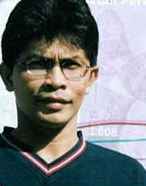 |
||
|---|---|---|
| CP Foundation | About CP Biennale | 2003 | 2005 | Contact Us | >||
           
|
||
|
Melodia paid special attention to bicycles, motorcyles and becak (pedicabs). These vehicles immediately show the kind of people he has been observing. They are the grassroots of Yogyakarta. Most of them are rural people who still live in a traditional manner and who have to struggle for their lives in the cities. The mobility of these people, indeed, is phenomenal. To some extent it shows the modernization process of the traditional people. In trying to find characteristics of people as refleceted by their vechicles, he does not measure actions, but rather scrutinize the relation of the vehicle with its users as a matter of the question concerning what people are doing to them, how they operate them. In the depiction of the static objects, Melodia tries to discover the dynamic signs that are left behind, the signs that indicate ideas and hopes of the people. Melodia uses the camera for recording these phenomenal realities. Photographs help him remember the details, the parts that strongly express the characteristics of the objects. As it happens to photographers, the process of determining objects and angles becomes an important phase in his realism. The problem arises is how to bracket the part of reality that can represent a wider reality. However, as the other artists do also, Melodia goes also beyond photography. He dramatizes the realistic depiction and creates tensions by cutting off the edges. "For me, those vehicles express the owner's attitude in facing modernization. Some of the vehicles show a conquering expression that means the owner use them as powerfull speedy machines. Some other vehicles show an expression somewhat like a tame animal and they look just lik tools which are dependable to the operators. These expressions, I think, are signals of a process of modernization in Yogyakarta that to me is a conservative city. In one way or the other, there is the anxiety of the traditional in facing changes, during and the process towards the forming of a modern society." Jim Supangkat Born on February 8, 1967 in Jakarta. SELECTED SOLO EXHIBITIONS SELECTED GROUP EXHIBITIONS |
||
|
CP Foundation | About CP Biennale | 2003 | 2005 | Contact Us
Jl. Suryopranoto 67A, Jakarta 10160, Indonesia. ph. +62.21.3448126, 3853206 | fax. +62.21.3853203, 3853208 info@cp-foundation.org |
||
 The spirit of the city of Yogyakarta in Melodia's paintings is expressed by way of representing mobility of people. He tried to find behaivior of the people when they moved from one place to anotherusing vehicles. He found that transportation explained mobilty of the people. The transportation also embodied interaction between the modern and the traditional.
The spirit of the city of Yogyakarta in Melodia's paintings is expressed by way of representing mobility of people. He tried to find behaivior of the people when they moved from one place to anotherusing vehicles. He found that transportation explained mobilty of the people. The transportation also embodied interaction between the modern and the traditional.